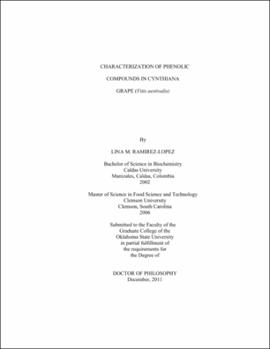| dc.contributor.advisor | DeWitt, Christina A. Mireles | |
| dc.contributor.author | Ramirez-Lopez, Lina Marcel | |
| dc.date.accessioned | 2013-11-26T08:22:38Z | |
| dc.date.available | 2013-11-26T08:22:38Z | |
| dc.date.issued | 2011-12 | |
| dc.identifier.uri | https://hdl.handle.net/11244/6618 | |
| dc.description.abstract | Scope and Method of Study: Identification and quantification of the major phenolic compounds in the extracts of Cynthiana whole grape, juice, grape pomace and commercial dried grape pomace using High Performance Liquid Chromatography Comparative fractionation of phenolic compounds on Amberlite XAD 7 HP and cellulose ion exchange from grape pomace using acetone and methanol-water mixture as polar solvents by UV-Visible spectroscopy. Evaluation of antibacterial activities of phenolic compounds eluted on Amberlite XAD-7 HP and Ion exchange resins using acetone orr methanol in Cynthiana pomace. | |
| dc.description.abstract | Findings and Conclusions: Phenolic acids, flavanols, flavonols and stilbenes (PAFFS) were isolated from Cynthiana (Vitis aestivalis) whole grape, juice, or pomace. Flavonoid-anthocyanins (FA) were isolated using methanol/0.1% hydrochloric acid extraction. In addition, crude extractions of phenolic compounds from Cynthiana grape using 50% methanol, 70% methanol, 50% acetone, 0.01% pectinase, or petroleum ether were also evaluated. Reverse phase high performance liquid chromatography (RP-HPLC) with diode array detector was used to identify phenolic compounds. A method was developed for simultaneous separation, identification and quantification of both PAFFS and FA. For whole grape samples nine phenolic compounds were tentatively identified and quantified. The individual phenolic compounds content varied from 3 to 875 mg kg-1 dry weight. For juice, twelve phenolic compounds were identified and quantified. The content varied from 0.07 to 910 mg kg-1 dry weight. For pomace, a total of fifteen phenolic compounds were tentatively identified and quantified. The content varied from 2 mg kg-1 to 198 mg kg-1. Results from HPLC analysis of the samples showed that gallic acid and (+ catechin hydrate were the major phenolic compounds in both whole grapes and pomace. Cyanidin and petunidin 3-O-glucoside were the major anthocyanins in juice. Extracts of methanol or acetone from Cynthiana pomace were applied to columns of Amberlite and Ion exchange resin and eluted with a mixture of CH3CN/TFA/H2O (50:0.5:49.5 v/v/v). Phenolic compounds were obtained by collecting 5 mL fractions and subjected to ultraviolet (UV)/visible (vis) spectroscopy. The intense red fractions produced the highest relative concentration than the clear fractions at 280, 320, 370 and 520 nm. Antibacterial activities of the intense red fractions using spot on-the lawn- assay were studied on E.coli, S.aureus and L.monocytogenes. It was found XAD resin using acetone showed the highest inhibition against all the tested bacteria. | |
| dc.format | application/pdf | |
| dc.language | en_US | |
| dc.rights | Copyright is held by the author who has granted the Oklahoma State University Library the non-exclusive right to share this material in its institutional repository. Contact Digital Library Services at lib-dls@okstate.edu or 405-744-9161 for the permission policy on the use, reproduction or distribution of this material. | |
| dc.title | Characterization of phenolic compounds in cynthiana grape (Vitis aestivalis) | |
| dc.contributor.committeeMember | McGlynn, William G. | |
| dc.contributor.committeeMember | Muriana, Peter M. | |
| dc.contributor.committeeMember | Bowser, Tim | |
| dc.contributor.committeeMember | Maness, Niels O. | |
| osu.filename | RamirezLopez_okstate_0664D_11898 | |
| osu.accesstype | Open Access | |
| dc.type.genre | Dissertation | |
| dc.type.material | Text | |
| dc.subject.keywords | antibacterial activities | |
| dc.subject.keywords | cynthiana grape | |
| dc.subject.keywords | extraction | |
| dc.subject.keywords | fractionation | |
| dc.subject.keywords | hplc | |
| dc.subject.keywords | phenolic compounds | |
| thesis.degree.discipline | Animal Science | |
| thesis.degree.grantor | Oklahoma State University | |
